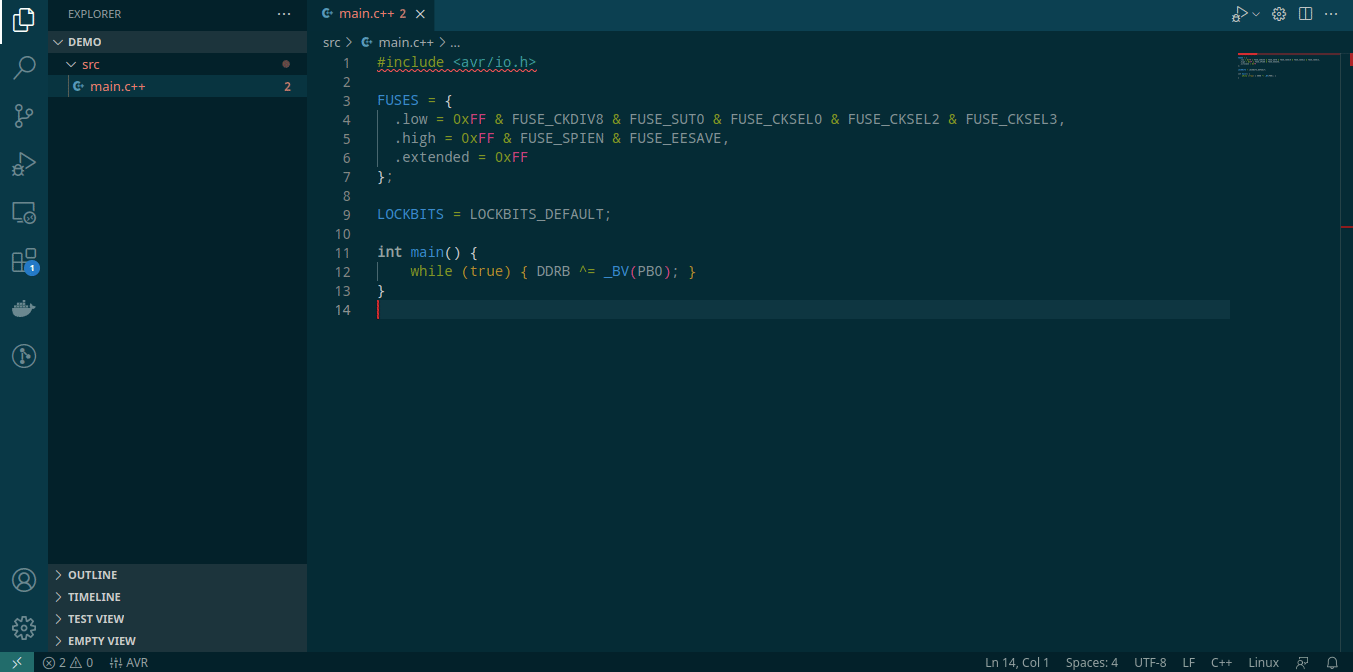Helper extension to simplify code compilation and flashing for AVR MCUs.
This extension allows building and flashing executable code for AVR from C/C++ source files. It needs avr-gcc and avrdude installed. It uses C/C++ extension to provide language support.
The goal of the extension is to provide a visual way of automating routine build and flash tasks.
The AVR Helper extension acts as a bridge between user-provided tools and does not include any MCU support code explicitly. The extension configuration leverages VSCode settings architecture.
Device list, programmer list, memory areas data is coming from avrdude output. The user is free to reconfigure the tools as required.
The C/C++ extension is configured with user-provided avr-gcc and external source code libraries.
Demo: source highlighting, building and flashing.
The AVR Helper adds six items to the window status bar:
Displayed as AVR
This is the starting point to configure build system.
- C/C++ extension configuration file is created when this item is activated
- Step 1: choose avr-gcc executable file
- Step 2: choose avrdude executable file
- Step 3: choose avrdude.conf
- Step 4: choose additional source libraries
Displayed as attiny85 | 1000000 Hz
This item displays and allows for selecting MCU type and frequency.
- Step 1: select MCU type according to the configured avrdude and avrdude.conf
- Step 2: input MCU frequency in Hz
Displayed as stk500v1 | /dev/ttyACM0 | 19200 Baud
This item displays and allows for selecting programmer type, port, and baud rate.
- Step 1: select programmer type according to the configured avrdude and avrdude.conf
- Step 2: choose OS port to which the programmer is connected
- Step 3: input the port rate in baud
Displayed as Build
This item triggers building of a currently open folder or a folder of currently displayed file. There are three options:
- Build: compile, link, disassemble, display ELF information
- Clean: remove the build output
- Scan: list all C/C++ files which will be used for build
The result of the build is output.elf file (optionally output.lst and output.hex as well) in the build folder.
Displayed as Flash
This item triggers a connection to the device using the programmer to list all available memory areas of the currently connected device. The user can select memory areas to flash, these areas must be present in output.elf file sections for the operation to succeed. The build has to be run successfully and produce output.elf file before flashing.
Displayed as Quick
This item triggers building and flashing with default options. This is equivalent to executing "Build" with option "Build" selected, skiping device check and immediately executing "Flash" with option "flash" selected.
- avr-gcc (compilation)
- avrdude (programmer driver and device capabilities)
- C/C++ extension (language support)
Debug and simulation modes are not implemented.
